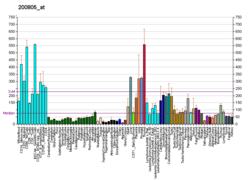LMAN2
Vesicular integral-membrane protein VIP36 is a protein that in humans is encoded by the LMAN2 gene.[5][6]
References
- 1 2 3 GRCh38: Ensembl release 89: ENSG00000169223 - Ensembl, May 2017
- 1 2 3 GRCm38: Ensembl release 89: ENSMUSG00000021484 - Ensembl, May 2017
- ↑ "Human PubMed Reference:".
- ↑ "Mouse PubMed Reference:".
- ↑ Nufer O, Mitrovic S, Hauri HP (Apr 2003). "Profile-based data base scanning for animal L-type lectins and characterization of VIPL, a novel VIP36-like endoplasmic reticulum protein". J Biol Chem. 278 (18): 15886–96. doi:10.1074/jbc.M211199200. PMID 12609988.
- ↑ "Entrez Gene: LMAN2 lectin, mannose-binding 2".
Further reading
- Maruyama K, Sugano S (1994). "Oligo-capping: a simple method to replace the cap structure of eukaryotic mRNAs with oligoribonucleotides". Gene. 138 (1–2): 171–4. doi:10.1016/0378-1119(94)90802-8. PMID 8125298.
- Suzuki Y, Yoshitomo-Nakagawa K, Maruyama K, et al. (1997). "Construction and characterization of a full length-enriched and a 5'-end-enriched cDNA library". Gene. 200 (1–2): 149–56. doi:10.1016/S0378-1119(97)00411-3. PMID 9373149.
- Füllekrug J, Scheiffele P, Simons K (1999). "VIP36 localisation to the early secretory pathway". J. Cell Sci. 112 (17): 2813–21. PMID 10444376.
- Strausberg RL, Feingold EA, Grouse LH, et al. (2003). "Generation and initial analysis of more than 15,000 full-length human and mouse cDNA sequences". Proc. Natl. Acad. Sci. U.S.A. 99 (26): 16899–903. doi:10.1073/pnas.242603899. PMC 139241. PMID 12477932.
- Zhang H, Li XJ, Martin DB, Aebersold R (2003). "Identification and quantification of N-linked glycoproteins using hydrazide chemistry, stable isotope labeling and mass spectrometry". Nat. Biotechnol. 21 (6): 660–6. doi:10.1038/nbt827. PMID 12754519.
- Søborg C, Madsen HO, Andersen AB, et al. (2003). "Mannose-binding lectin polymorphisms in clinical tuberculosis". J. Infect. Dis. 188 (5): 777–82. doi:10.1086/377183. PMID 12934195.
- Breuza L, Halbeisen R, Jenö P, et al. (2004). "Proteomics of endoplasmic reticulum-Golgi intermediate compartment (ERGIC) membranes from brefeldin A-treated HepG2 cells identifies ERGIC-32, a new cycling protein that interacts with human Erv46". J. Biol. Chem. 279 (45): 47242–53. doi:10.1074/jbc.M406644200. PMID 15308636.
- Gerhard DS, Wagner L, Feingold EA, et al. (2004). "The status, quality, and expansion of the NIH full-length cDNA project: the Mammalian Gene Collection (MGC)". Genome Res. 14 (10B): 2121–7. doi:10.1101/gr.2596504. PMC 528928. PMID 15489334.
- Nawa D, Shimada O, Kawasaki N, et al. (2007). "Stable interaction of the cargo receptor VIP36 with molecular chaperone BiP". Glycobiology. 17 (9): 913–21. doi:10.1093/glycob/cwm067. PMID 17586539.
This article is issued from
Wikipedia.
The text is licensed under Creative Commons - Attribution - Sharealike.
Additional terms may apply for the media files.




